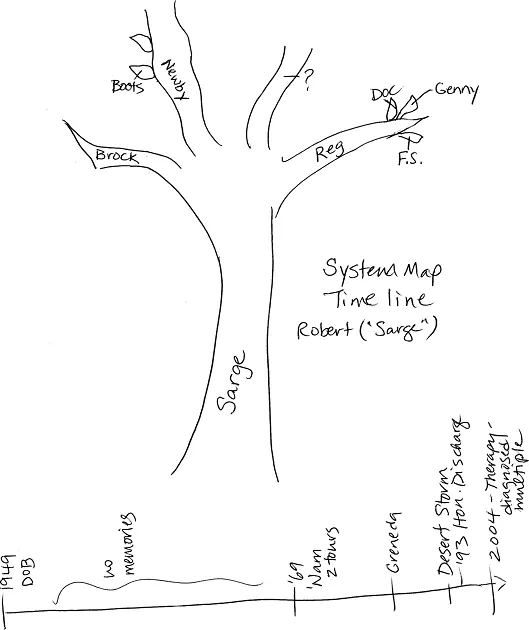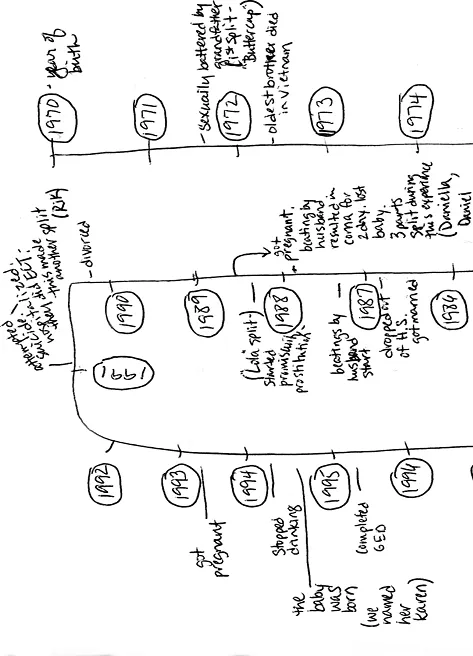![]()
~~You are not alone~~
No, really. Literally.
Maybe you have always known (or suspected) this. Maybe this news is shocking, baffling, dismaying, even unbelievable to you. Despite what you might believe or may have been told about yourself, you are not just ‘moody’. Nor are you crazy or defective or possessed. You have what is commonly called ‘multiple personalities’.
What used to be called Multiple Personality Disorder (MPD) has now been re-classified in the DSM IV diagnostic manual as Dissociative Identity Disorder (DID). Multiple personalities arise from traumatic events, things which are so overwhelming to body, mind, emotion, and spirit, that in an attempt to cope with—to physically or emotionally survive the event—a separate personality state, also known as a part, or an alter or alter personality, emerges to survive what is happening. This is known as splitting. One way of understanding personality states might be to think of it this way: when you think of a person you know, you are actually relating to or interacting with a ‘personality state’. Usually there is one personality state (think of it as the ‘driver’) per one physical body (think of this as the ‘vehicle’). In the case of someone who is has multiple personalities—DID—the vehicle (body) has more than one ‘driver’.
The entirety of alters (or parts) which co-exist inside one individual physical body is known as a System.
Going back and forth between first one alter being ‘out front’ or ‘presenting’ (interacting with the outside world), then another alter coming to the fore to be out, is known as switching.
There is no shame in being DID. Having multiple personalities does not reflect a weak or flawed character, rather, the opposite. It is a testimony to the strong, creative, courageous human spirit, and its psychic imperative to survive.
These other alters—parts—are every bit as real as you are. It is essential that you become aware of all the alters who are a part of you, that you get to know each other, and that you become able to trust each other. In order to function successfully it will be critical that you-all work together to heal and reclaim your life/lives, and work toward developing a shared goal or vision of where and how you see yourself functioning in the outside world.
Parts are never going to disappear or go away; they will always be there, and part of you. Individual parts will always remain separately individual, but the goal of re-integration is to become aware of each other and working so seamlessly and cooperatively together, with shared information and regarding switches, that you can live and function in the outside world with a minimum of distress, without others even knowing about your multiplicity unless you choose to disclose it.
With belief, time, and a lot of hard work, it is possible to live not just a survival-level functional existence, but a rich and satisfying life with multiple personalities co-existing within the same physical body.
But it’s not easy.
That’s the idea behind this book: to share information culled from others who are also DID and who have learned from hard experience what works, what doesn’t; what it takes to manage this diagnosis and to recover from the trauma that caused the splitting in the first place; and what it takes to have a System of alters who are working toward ever-higher levels of re-integration and who, in doing so, are living a better life than they ever thought possible. So…
“Just Sit Right Back And You’ll Hear A Tale…
of what has worked for others….” ~~Getting to Know You~~
Getting To Know You, Getting To Know All About You It is essential to get to know each individual alter, and the System-as-a-whole.
Once you, or your therapist have encountered an alter for the first time, that is the time to begin the process of getting acquainted with that part.
There is often upset, fear, confusion, anxiety—many emotions which you or the other alter may be feeling. The newly discovered part may or may not know where they are, or that time—sometimes years—has passed since they split off, or since they have last been ‘out’, and that circumstances have changed.
Go slowly, gently, and respectfully as you are getting to know newly-discovered parts…try putting yourself in their shoes and imagine how they might be feeling.
It’s important to create an atmosphere and an environment in which this newly discovered part can feel as safe and welcome as possible. It will be very important to brief them on the System—to have them meet and get to know everyone else inside, and to come to understand how life is now, and how it differs from how it was when they split off.
Some Systems find that having a notebook in which you-all can write, and in which you can write to each other, can help facilitate this slow process of getting to know who all is a part of your System, what the other parts are like, and begin to build foundations of trust.
In order to get to know who is in your System, each individual alter needs to complete a piece of paper in the form of a circle (or triangle) which contains the following information: their name, their age (it might be an age range, like age 4-7), and their traits, strengths and skills. (All parts must have a name. If they do not have a name, they need to choose one. If their name was given to them by a perpetrator and is too upsetting or if it has a negative association, they may wish to change their name—that is perfectly ok. Any name that is not negative or triggering is fine—it does not have to be a standard ‘proper name’ as they are commonly thought of.) On the back of the circle or triangle they need to write down what caused them to split off.
Having a circle or triangle completed is a pre-requisite to entering the Safe Space/Dome explained a little later on page 15.
Parts (alters) also each need to write their individual histories—their life stories—as much as they can remember. Even if clearly recognizable memories are lacking, with only ‘pictures’ in their head, or fragments of something recalled it’s important to write these down. Alters should do this even if they do not fully understand them, (or sometimes even believe them initially). Parts can always come back and examine them later, and to clarify, and/or add to these pictures or memory fragments if they remember things later.
Remembering things or processing memories can be a charged, or frightening, or uncomfortable time. It can help to imagine yourself being a reporter. This can take pressure off of needing to remember ‘all the details’ or not wanting to ‘be wrong about something’, if you simply just write down whatever comes to you down on paper without editing it, censoring it, or passing judgment—for the time being—on either its content, or on whether it is 100% accurate in every way. Simply write it down and come back to it later, when things may make more sense, or as additional information comes to you (or another part provides helpful information based on their own memories or information).
Young parts can dictate their story for someone else to write down, or they can draw it with pictures.
System-as-a-whole information can be learned by completing the following two projects: a System Map and a Timeline.
These two projects are tools to provide graphics which can aid in getting a different kind of look at your overall System. You can then gain a different perspective on information you may or may not already know, and see connections that may help you to understand your System better.
The System Map is like an internal family tree, though it can be drawn out in whatever format, in whatever way is easy for the System to understand. It will contain and illustrate information such as who split off from whom and how you all relate to each other. As you become more aware of your System over time, your System Map may grow as you encounter newly discovered parts. It may also change over time as you come to have greater understanding of your System and how you all relate to and interrelate with each other. Some System Maps appear on the following pages:
System Map (above) and Timeline (below) for Robert (“Sarge”)
The Timeline is a straight line drawing accounting for the current age of the body, starting the year the body was born, marked off year by year, and continuing to the present year. Traumatic events and other important occurrences should be written down in the year they occurred, along with entries of who split off when. Just like the System Map, your Timeline may fill in more as you continue to do this work, continue to remember things, and continue to get to know your System, as some parts may have information that others in the System may not...










